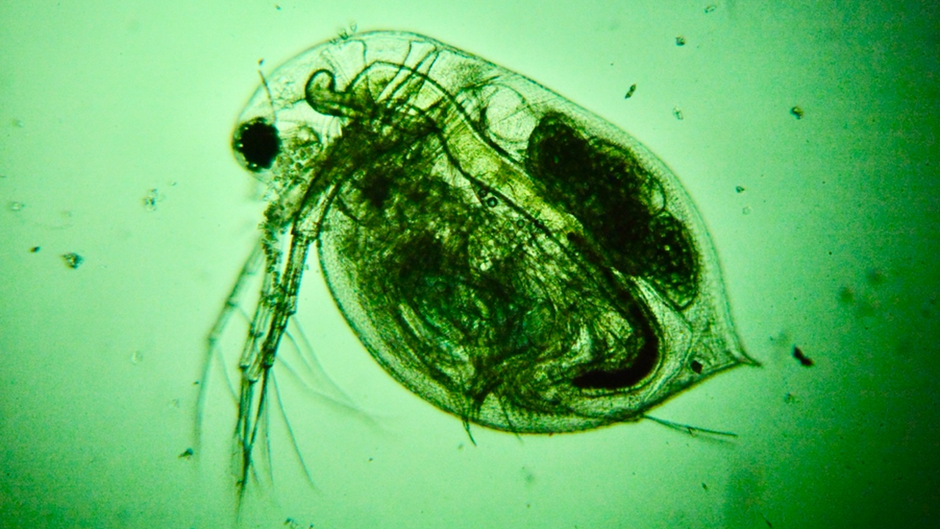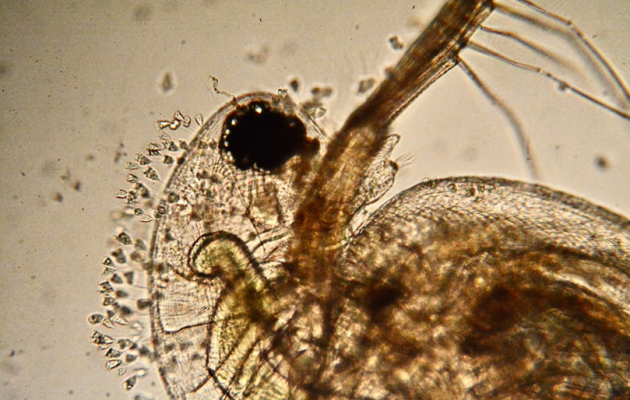Each human being has some 23,000 genes, while the water flea has about 31,000, but clustered together in a genome that is 15 times smaller than the human genome.
 There are numerous species of freshwater fleas, belonging to the genus Daphnia, which are planktonic crustaceans. / Photo: Antonio Cruz.
There are numerous species of freshwater fleas, belonging to the genus Daphnia, which are planktonic crustaceans. / Photo: Antonio Cruz.
It was 11.00 am on December 27th, 2022. We had just reached our longed-for destination: the pool at the Casa de la Mata, situated at an altitude of 912 metres in the Sant Llorenç de Munt massif (Barcelona), to see its frozen surface.
My granddaughters were eager to throw pieces of ice into the little pond and watch them skate speedily across the surface, just as they had done several years before. However, this year the climatic conditions were very different. There was no ice, and the transparency of the water revealed many tiny aquatic insects, like the ubiquitous common backswimmer, calmly gliding through the water with the help of its huge oar-like back legs.
The girls soon forgot about the ice and instead cut enormous bullrushes and used them to chase the backswimmers, which could both swim under the water and fly through the air. After harassing these aquatic insects for a few minutes, my youngest granddaughter shouted: “There are lots and lots of bugs here!” I went over to have a look and, sure enough, there was a cloud of hundreds of little white water insects, between one and two millimetres in length, swimming together like a tiny shoal of sardines. I fetched a small plastic bottle and collected part of the cloud of insects so as to observe them more closely. In fact, they weren’t insects at all but crustaceans: the common water flea of the Daphnia genus, a unique invertebrate plankton, the complexity of whose genome has surprised geneticists. It turns out to have more genes than the human being!
Each human being has some 23,000 genes, while the water flea has about 31,000, but clustered together in a genome that is 15 times smaller than the human genome. How can a minute aquatic crustacean be more complex, in genetic terms, than a human being?
The genome of this microcrustacean was sequenced in 2011 and it was discovered that its huge number of genes is attributable, in part, to the high rate of duplication which produces them in tandem [1]. But this duplication of the genes is not random, but rather is due to the diversity of the environmental challenges that these organisms will face, such as predators, toxic chemical products, extreme temperature variation, etc. In other words, it is the environment that determines which genes are expressed and which are not, as was discovered recently by epigeneticists. Besides, 36% of the Daphnia genes are exclusive to these crustaceans. They are not present in any other living organism and appear to be associated, as pointed out above, with developing an effective response to the environmental challenges. Their reproduction is usually sexual, but when conditions require, they can reproduce by asexual cloning. All this implies prior genetic programming with the aim of solving future environmental problems. And, as is known to be the case, all programming necessarily requires a Programmer. There can be no such thing as random programming capable of anticipating future scenarios.
For example, it is common knowledge that cadmium is a very toxic contaminating agent for most aquatic organisms, and can also be lethal for human beings. However, water fleas can very quickly adapt to high levels of this metal, thanks to a special protein produced by their genes at just the right moment, an the same applies to a range of other contaminating agents. This phenomenon has surprised scientists to such an extent that it has contributed, along with other factors, to the creation of this new epigenetic discipline, sometimes known as environmental genomics, which explores how the environment interacts with an organism’s genes.
Another interesting fact about the water flea is that it has in common with human beings many more genes than any other arthropod whose genome has been studied so far. Gorillas are known to share with humans between 95% and 99% of their genes; chimpanzees up to 96%; cats and pigs 90%; mice 85%; cows and bulls 80%; dogs 75%; fruit flies 75% and vegetal organisms such as bananas 60%. Does this mean that we are so many percent apes, cats, pigs, flies or bananas? Are we only the sum total of what is specified in our genes, or is there not much more to us than our DNA?

[photo_footer] The freshwater flea (Daphnia pulex) feeds on microscopic algae. / Photo: Antonio Cruz. [/photo_footer] Biological dogma centred around genes, which predominated during the entire 20th century, consisted of the belief that the information contained in our DNA is transcribed in RNA and that this translates into proteins. Therefore, we would be entirely the result of what is written in our DNA. However, we now know that this is only a half-truth, which distorts reality. In recent decades sufficient evidence has accumulated that there are complex systems of epigenetic legacy that are capable of transmitting variations not related to our DNA. It has been observed that, after the DNA sequences have been transcribed to RNA, much of this RNA is modified and no longer coincides with the original transcription.
This occurs by means of so-called RNA splicing in cells with a nucleus, which means that the DNA sequences that codify proteins are interrupted by segments, known as introns, which do not codify proteins. When DNA is transcribed, these introns are included among the RNA messengers, but then they are cut off and disappear, whereupon the regions that do produce proteins rebind with each other. These bindings and splices can occur in a number of alternative ways, as a result of which many RNA messengers end up having sequences that no longer correspond to those of the original DNA. All this has been studied, in particular, in the fruit (Drosophila melanogaster), and the RNA of one sequence of its DNA has been shown to be able to generate more than 18,000 different proteins by means of this kind of splicing. In fact, this same thing occurs in all vegetable and animal species, including human beings.
Besides this kind of cutting and splicing, there is also what is called “RNA editing”. This is a process which habitually occurs in human cells [2], but also in other animals and , and it consists in the substitution of a nitrogenous base for another in an RNA messenger molecule. This causes the RNA messenger affected to change its sequence, and that of the protein’s amino acids which it translates, which can thus also change their function. It was studied in depth in the long-fin coastal squid (Doryteuthis pealeii), and it has been shown that in its brain cells, the RNA messenger was edited outside the nucleus of the nerve cells, in the so-called axon. This allows the species of squids to adapt the proteins they produce to the environment in which they live, both the cold waters of the Antarctic, and the warm waters of the tropics [3]. Therefore, the sequences of the proteins formed in this way no longer coincide with the original DNA sequence.
On the other hand, it is common knowledge that the function of the proteins also depends on its three dimensional form, which is not always specified by the amino acid sequence that it is made up of. Some proteins adopt similar 3D forms, despite having very different amino acid sequences [4] and, vice versa, in that other proteins, with different 3D forms turn out to have the same or a very similar amino acid sequence. The latter are known as “metamorphic” proteins [5]. Finally, the proteins can be modified chemically by means of the addition of sugar molecules and change in time in accordance with the organism’s needs [6].
What all this means is that the final expression of the biological information that the genes carry depends on other factors, is so complex and changes so much that it goes far beyond the DNA. It could be argued that the old central biological dogma “one gene, one protein” is dead. The belief that the genome contains all the information that is necessary to form an organism is quite simply false. For this reason, animals that are very different can have very similar development genes.
Those who state, for example, that chimpanzees and humans have between 96% and 98% of their genes in common, and this is interpreted to mean that the two species have a common ancestor which must have lived some six million years ago, forget the fact that the genome of both species generates proteomes (or the sum total of an organism’s proteins) which are very different. It so happens that this great similarity between the DNA of apes and that of human beings decreases significantly to only 20% in terms of protein similarity. In other words, 80% of the proteins that make a human body work have absolutely nothing in common with those of other apes. It must be stressed that proteins are, in fact, the molecules that are commissioned with the task of performing all the biological functions at the cellular level. This means that the DNA information is expressed differently depending on the species that possesses it, and the environment that it inhabits.
While it is true that the freshwater flea has more genes than us, and many of these genes resemble our own, this does not imply that we have descended from them, or from any ancestral ape. Materialists may well continue to believe in DNA determinism, but, as has been argued in this article, DNA is far from being the secret of life.
1. Colbourne, J. K. et al., 2011, The Ecoresponsive Genome of Daphnia pulex, Science, Vol. 331, Issue 6017, pp. 555-561. DOI: 10.1126/science.1197761
2 Bahn, J. H., et al., 2015, Genomic analysis of ADAR1 binding and its involvement in multiple RNA processing pathways, Nature Communications, Vol. 6, Art. N. 6355.
3 Vallecillo-Viejo, I. C. et al., 2022, Spatially regulated editing of genetic information within a neuron, Nucleic Acids Res, 48 (8):3999-4012.
4 Rusell, R. B. & Barton, G. J., 1994, Structural features can be unconserved in proteins with similar folds, Journal of Molecular Biology, 244: 332-350.
5 Murzin, A. G., 2008, Metamorphic proteins, Science, 320: 1725-1726.
6 Spiro, R. G., 2002, Protein glycosylation: Nature, distribution, enzymatic formation, and disease implications of glycopeptide bonds, Glycobiology, 12:43R-56R.

Las opiniones vertidas por nuestros colaboradores se realizan a nivel personal, pudiendo coincidir o no con la postura de la dirección de Protestante Digital.
Si quieres comentar o